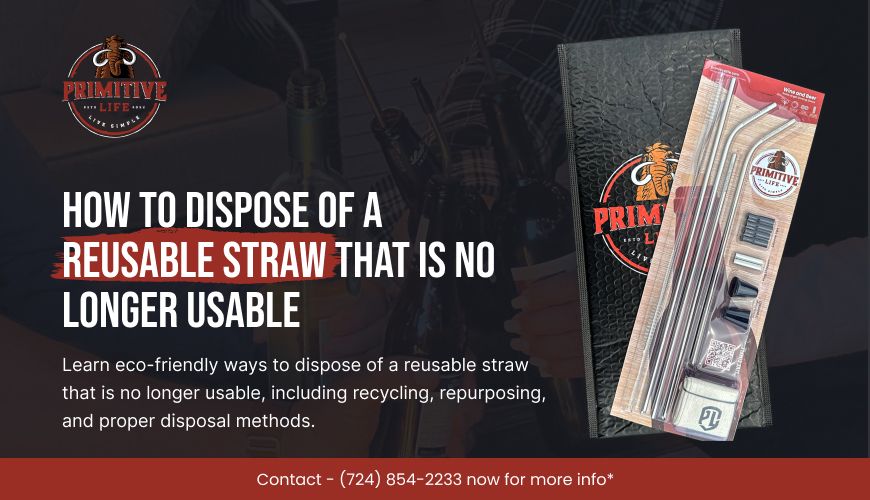Primitive Life -

Reusable straws have become popular as a sustainable alternative to single-use plastic straws. They are typically made from materials like stainless steel, silicone, bamboo, or glass, and can be used multiple times, reducing waste and environmental impact. However, there comes a time when even reusable straws reach the end of their lifespan. Disposing of them properly is essential to ensure they don't contribute to environmental pollution. In this blog post, we'll explore various methods for disposing of reusable straws that are no longer usable.
Assessing the Condition of Your Reusable Straw
Before deciding to dispose of your reusable straw, it's important to assess its condition. Check for signs of wear and tear, such as cracks, bends, or discoloration. If the straw is damaged beyond repair and poses a risk to your health or safety, it's time to consider disposal options.
Recycling
One of the most environmentally friendly ways to dispose of a reusable straw is through recycling. The recyclability of your straw depends on the material it is made from:
- Stainless Steel Straws: Stainless steel is a highly recyclable material. You can take your stainless steel straw to a local recycling center that accepts metal items. Ensure the straw is clean and free from any residue before recycling.
- Silicone Straws: Silicone can be recycled, but not all recycling centers accept it. Check with your local recycling facility to see if they accept silicone items. If they do, clean the straw thoroughly before recycling.
- Bamboo Straws: Bamboo is a natural material that can be composted. If you have a compost bin, you can break the bamboo straw into smaller pieces and add it to your compost. Alternatively, you can check if your local composting facility accepts bamboo.
- Glass Straws: Glass is recyclable, but it must be handled carefully to avoid breakage. Wrap the glass straw in newspaper or a similar material to prevent it from shattering, and take it to a recycling center that accepts glass items.
Repurposing
If recycling is not an option, consider repurposing your reusable straw. There are several creative ways to give your straw a new life:
- Craft Projects: Use your straw in various craft projects. For example, you can cut it into smaller pieces and use them as beads for jewelry making or as spacers in art projects.
- Garden Markers: Cut the straw into segments and use them as markers for your garden plants. Write the name of the plant on the straw with a permanent marker and place it in the soil next to the plant.
- Storage Containers: Use the straw to organize small items like beads, buttons, or screws. Cut the straw into sections and use them as dividers in a storage container.
Donation
If your reusable straw is still in decent condition but you no longer need it, consider donating it. Schools, community centers, and art studios may find creative uses for reusable straws in their projects. Contact local organizations to see if they can make use of your straw.
Proper Disposal
If recycling, repurposing, or donating are not viable options, you may need to dispose of the straw in the trash. Here are some tips for proper disposal:
- Clean the Straw: Ensure the straw is clean and free from any residue before disposing of it. This helps prevent contamination and makes the disposal process more hygienic.
- Break It Down: If possible, break the straw into smaller pieces. This reduces the volume of waste and makes it easier for waste management facilities to handle.
- Dispose Responsibly: Place the straw in your regular trash bin. Avoid disposing of it in nature or public spaces, as this can contribute to environmental pollution.
Environmental Considerations
When disposing of a reusable straw, it's important to consider the environmental impact. Reusable straws are designed to reduce waste, but improper disposal can negate their benefits. Here are some environmental considerations to keep in mind:
- Material Impact: Different materials have varying environmental impacts. Stainless steel and glass are highly recyclable, while silicone and bamboo may require special disposal methods. Choose the disposal method that minimizes environmental harm.
- Waste Reduction: Aim to reduce waste by repurposing or recycling your straw whenever possible. This helps conserve resources and reduces the burden on landfills.
- Sustainable Choices: When purchasing reusable straws, consider their lifespan and disposal options. Opt for materials that are easily recyclable or compostable to ensure a sustainable end-of-life process.
Disposing of a reusable straw that is no longer usable requires thoughtful consideration of the material and available disposal options. Recycling, repurposing, and donating are environmentally friendly methods that can give your straw a new life. If these options are not feasible, proper disposal in the trash is necessary to prevent environmental pollution.
By making informed choices about the disposal of reusable straws, you can contribute to a more sustainable future. Remember to assess the condition of your straw, explore recycling and repurposing opportunities, and consider the environmental impact of your disposal method. With these steps, you can ensure that your reusable straw is disposed of responsibly and sustainably.




